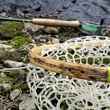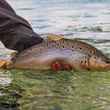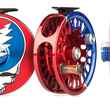Loop knots have an integral place in the way most experienced anglers rig their flies. Despite common misconception, there are a great many loop knots that are exceedingly simple to tie. Sure, there are loop knots that are cumbersome or even difficult to tie, but some of the best loop knots are easy to learn and to tie streamside. But the main reason that most experienced anglers readily use loop knots is that, in a great many scenarios, loop knots provide significant advantages over knots that are fixed to the fly's hook eye.
Following are a few reasons why, if you're not already regularly using loop knots in your fishing, you should be. Even beginner anglers will likely be familiar with the most common of these reasons, but the others may be new information even to some of you who've been at it for a while.
Better / More Natural Fly Movement
This is the justification for loop knots that most anglers learn first and usually in the context of streamers or flies like the wooly bugger. Flies that are supposed to represent larger, swimming insects in the water have a significantly more natural movement when attached to your leader or tippet with a loop knot. Instead of being attached with a rigid, fixed connection that restricts the fly's movement, a fly on a loop knot can slide and float more freely, producing a more natural action.
But this doesn't apply to only streamers. I often encounter anglers that have worked loop knots into their repertoire when fishing streamers, but limit their use to those scenarios. The same principle that applies with streamers also applies to wet flies and most certainly applies to dead drifting nymphs.
A more natural movement of the fly results in a greater number of takes and that results in a higher catch rate. Simple.
Sink Your Fly Faster
In his book, Fly Fish Better: Practical Advice on Tackle, Methods, and Flies, noted angler and author Art Scheck highlights a lesser known reason for choosing a loop knot for your terminal connection: faster fly sink rates. The logic behind Scheck's contention is that a weighted fly (tungsten bead head, lead bead chain eyes, etc) can adopt a nose-down position and sink faster when its connection to the leader or tippet is a flexible one. According to Scheck, though this effect is more noticeable in still water it also offers an advantage when using a strip-pause retrieve, allowing the fly to sink more readily during the pause.
Though the advantages loop knots offer to flies that need to get deep may not be pronounced, it offers anglers another reason to choose a loop knot when rigging their flies especially when considering that many of the situations described above in which the angler is seeking freer, more natural movement for their flies are also situations during which the angler is hoping to get their fly down deep, often quickly.
Break Fewer Knots
While all specific claims about knot strength and breakage rates should be taken with an enormous grain of salt, it is valuable to consider that some loop knots are widely held to be stronger than their fixed-connection counterparts. My personal favorite loop knot, the Non-slip Mono Loop knot, is considered by many anglers to have 100% knot strength. While remembering what I just said about treating strength rate claims and such as considerably dubious, keep in mind that means many experienced anglers are suggesting that tying the non-slip loop will in no way degrade the strength of your leader or tippet. You'll have a hard time finding people to make that claim about fixed knots such as the clinch knot, improved clinch knot or even the Orvis knot.
































Comments
ginkthefly replied on Permalink
I've always wondered why I break off fish so less often with my nymph rigs than my dry fly rigs. I've always found it counter-intuitive given that nymphs are the ones where the rig is bouncing along under the surface getting banged up by rocks and sticks and such, yet when I break a fish off it's almost always on a dry. I wonder if it is because I usually use loop knots to tie my nymphs on.
Andy Steer replied on Permalink
You might also like to try these loop knots:
Lefty's Loop https://youtu.be/F7C97ltJnzg
Kryston Non-Slip Loop https://youtu.be/ZzOL2Ps1aRQ
Jim Rauch replied on Permalink
I agree 100% with this article, my fly tying instructor with T.U. showed some of us the non-slip mono loop and I use it on every fly except dries. Can't recall one ever breaking or slipping.
Ray replied on Permalink
Three reasons not to use loop knots
1. Lops spin flyies when fast stripping or retrieving in fast currents, thus twisting leaders.
2. Loops slide back and forth against metal hook eyes when fighting big fish which creates abrasion
3. Loops are more easily seen by wary fish like permit and carp.
FRANK CADA replied on Permalink
I would think that the competitive anglers who use the contact type nymphing would use a loop knot if they thought it was an advantage. They want their flies to sink very fast to get to the bottom as soon as possible. I don't see them using loop knots in the reading I have done eg Devin Olson or George Daniels. They tend to use a tag dropper. I can't see where a loop knot would help here as the fly is free to move. They could use it on the point fly but they don't show this in their books. I am going to use loop knots only on streamers.
Paul replied on Permalink
I was skeptical to say the least about loop knots at first,when reading about knots 15 years back, specifically the non-slip mono when I read that it will... " nearly double your catch rate" ...yea BS is what I thought. Until trying the knot and using it religiously, it easily made me a believer. Yes it will up your chances of a fish taking your fly. No doubt! The smaller the fly the more likely the take using a loop knot. FACT: Clinch knots do interfere with movement of your fly. Oh, and as added bonus... you will know immediately if your knot is tied correctly with a non-slip mono loop. If it isn't tied correctly, it will break immediately 100% of the time when you tighten it down.
John replied on Permalink
No mention of dry flies and loop Knots, from Salmon flies to caddis- fun to watch them pivot freely in currents and more fun to watch the trout/steelies take um!
Pages